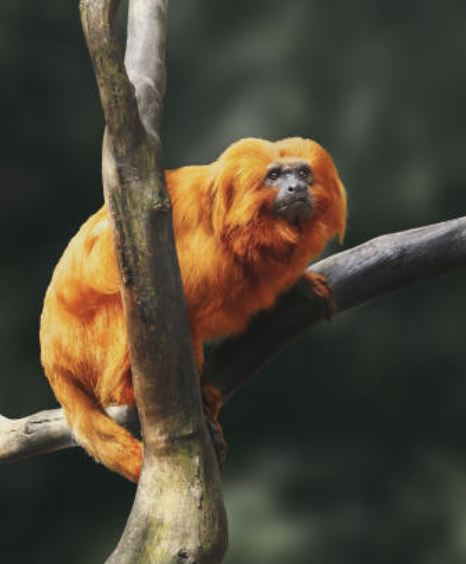Rainforest Biome
Rainforest Characteristics
Rainfall: The word "rainforest" implies that these are the world's wettest land ecosystems. Rainforests generally receive very high rainfall each year, although the exact amount varies among different years and different forests. For example, South America's tropical rainforests receive between 80-120 inches (6.5-10 ft) or rain each year. Despite relatively consistent rain in these ecosystems, there are distinct dry seasons in some rainforests. Wet and dry seasons of tropical rainforests very in their timing, duration and severity around the globe. They also have high humidity around 88% during the wet season and 77% during the dry season.
Temperature: These ecosystems typically are found near the equator between the Tropic of Cancer and Tropic of Capricorn. The equator receives direct sunlight and this radiation produces consistently high temperatures throughout the year. A average daytime temperature is 85F, although it could be much higher.
Layers: Rainforest ecosystems are made up of a forest floor, understory (65 ft), canopy (95ft), and emergent layer (100+ft). 
Biodiversity: These ecosystems have high biodiversity when compared to other ecosystems. Biologist estimate that rainforests contain about 50% of the world's terrestrial plant and animal species, yet they only take up 6% of the world's land area. Each rainforest is unique and you will not necessarily find the same species living in all of the rainforests around the world. For example, the species in an African rainforest are not the same species living in the Central America rainforest.
Species in Rainforest Biome
Linne's Two-Toed Sloth (Choloepus didactylus)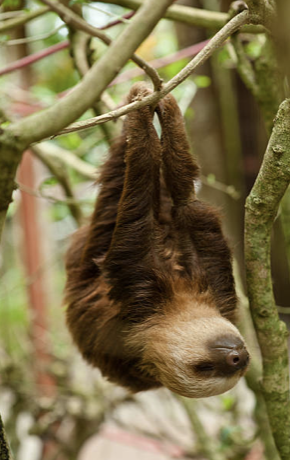
TMA’s Linne's Two-Toed Sloth
Name: Jeffrey
DOB: 7/27/2023
Came to TMA: 9/16/2024
Where we got him from: Roger Williams Park Zoo, born in human care
Size
21-29 inches in length and 10-20 pounds in weight. Claws can be 3-4 inches long.
Range
Two-toed sloths are arboreal and live in the tropical and cloud forests of Central and South America.
Diet
Sloths eat a variety of leaves, stems, buds, and some fruit. This diet does not contain much nutritional value, therefore a sloth cannot expend much energy.
Lifespan
About 15 years on average
Reproduction and early life
Sloths are solitary until mating, where females let out a nightly scream when they are ready. Alerted males travel to her and will fight, in slow motion, any other males nearby.
Gestation period is about 7 months, giving birth to one offspring, upside-down.
Young offspring cling to their mothers hair and make their ways to their belly where they nurse, rest, and eventually eat little amounts of solids (starting around 10 days). The offspring can first hang on it's own at about 25 days, but continue to stay with mom until about six months- two years.
Young sloths who have just left their mothers stay within the same general area as sloths are not territorial.
Adaptations
Two-toed sloths have two claws on their front feet and three on their back feet whereas a three-toed sloth has three on both the back and the front.
Their long claws curve around branches of trees with a tight grip. So strong that if the sloth dies, most times they stay gripped onto the tree branch.
Sloths have a large, four-chambered stomach, like a cow. Bacteria in their gut help digest the large amount of plant matter they eat. Their digestive system works very slowly and can take up to a month to digest a meal.
A two-toed sloths slow metabolism actually aids them in healing and allows them to survive injuries that would otherwise kill a normal metabolic mammal.
Two-toed sloths are made up of 25% muscle mass which is quite low for a mammal of their size. This decreased muscle allows them to stay lighter, which makes life in a tree easier.
Sloths are known for how slowly they move, they do this due to their low energy diet. In addition they sleep 15 hours a day to conserve energy.
To adapt to their life upside down, a sloths heart, liver, and spleen are placed differently than in other mammals.
While sloths live a life in the trees, they venture down periodically and can even swim quite well using their long arms and legs.
Sloths have a keen ear for low frequency, and vocalize using a series of grunts, squeals, and hissing.
Males mark trees with a sent gland located on their rump.
Conservation
IUCN lists two-toed sloths as least concern with current data showing populations as stable.
Threats to these populations include deforestation due to logging in Amazonia. Animals who are arboreal are specifically vulnerable to deforestation.
They are also hunted for meat in their natural habitats. Other human threats include power line accidents, road strikes, and illegal wildlife trafficking.
Natural History
Many people are familiar with the prehistoric Giant Ground Sloths. The Shasta Ground Sloth and the Long Claw Ground Sloth who both lived during the late Pleistocene. The Shasta grew approximately 9 feet and 550 lbs while the Long Claw grew 10 ft and weight 2200 lbs.
"The ancestors to the Shasta Ground Sloth evolved initially in South America and then crossed the Isthmus of Panama to North America roughly 2.6 million years ago. The intermittent movement of different types of animals between North and South America throughout the Pliocene and Pleistocene epochs is known as the “Great American Biotic Interchange.” This phenomenon brought today’s opossums, porcupines, and armadillos to North America and today’s foxes, lamine camels (llamas), and small cats to South America. Nothrotheriops was not closely related to two- nor three-toed tree sloths that are alive today in Central and South America"
"Prior to the formation of the Isthmus of Panama, relatives in the same family of sloths as Megalonyxwere able to distribute between South America and islands in the Caribbean. The Long Clawed Giant Sloth shares a common ancestor that evolved in South America with its closest living relative, the three-toed sloth. At some point, one lineage adapted to climbing and spending most of its life in trees, while the other lived primarily on the ground."
https://www.nps.gov/articles/000/giant-ground-sloths.htm
Golden Lion Tamarin
Species: Golden Lion Tamarin
IUCN: Endangered
Native Range: Atlantic coastal regions of southeastern Brazil. They live in humid forests and occupy the closed canopy, often remaining 29 to 100 ft off the ground.
Lifespan:
Native Range- up to 8 years
Human Care- up to 20 years or more
Diet: omnivorous – feeding on fruits, insects, and small invertebrates. Any smaller animal is possible food.
Adaptations: Long, slender fingers and hands to probe into crevices, bark, bromeliads and other hiding places for their prey.
Social Structure: golden lion tamarins are a social species. In their native range, they live in groups of two to eight family members. The groups comprise a breeding pair, offspring of one or two litters and possibly other relatives.
Reproduction: Each group has one breeding pair. The breeding season is between September and March, the warmest and wettest time of the year. Females’ gestation period lasts about four and a half months and they will usually give birth to twins. Golden lion tamarins cling to their mothers for the first few weeks after birth and they are weaned at 3 months. A male golden lion tamarin will reach sexual maturity at 2 years where as females reach sexual maturity at 18 months.
Conservation Efforts: In the early 1970s, there were as few as 200 golden lion tamarins in the wild due to habitat loss and climate change. They were upgraded from critically endangered to endangered in 2003 following intensive conservation efforts including release programs from many AZA Zoos & Aquariums. About one-third of the wild population today originated from golden lion tamarins raised in human care.
Individual
Name: Harley
Age: 10
Sex: Male
History: From Zoo Atlanta & here to be a social companion for Tonks.
Geoffroy’s Tamarins (Saguinus geoffroyi)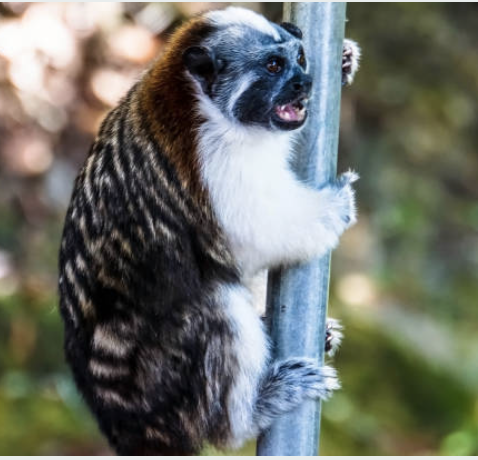
These are small primate species. Males and females look similar; Geoffroy's tamarins have brown and black fur with a red nape and a very distinctive “v” shaped mark on their heads and no fur on their faces.
Size: They are about 7-12 inches in length plus a tail of about 12 inches and weigh between 0.5 - 2.0 pounds.
Natural Range: Geoffroy's tamarins are found in lowland tropical forests and wooded areas in Panama, Columbia and Costa Rica.
Communication: Geoffrey’s tamarins scent-mark the tree branches that are used as regular trails where their range overlaps with another group’s. Tamarins tongue-flick before copulation and in highly aggressive contexts. Scowling is another facial display that is common during aggressive interactions. Ten different calls have been recognized by this species. A long whistle is a long distance intra-group call. Trills are given in hostile situations and at potential predators. Long rasps are heard when there is a violent, antagonistic encounter. Loud long calls are being used for territory defense and soft long calls are used in intra-group cohesion.
Diet : The Geoffroy's tamarin is an omnivorous animal meaning that the Geoffroy's tamarin preys on both plants and other animals in order to survive. Fruits, insects and green plants make up the majority of the Geoffrey's tamarin's diet along with small rodents and reptiles, eggs and tree sap.Here they are fed canned marmoset diet, bananas, grapes, apples, string beans, fruit and mealworms.
Social Structure :Geoffroy's tamarins are very sociable animals and inhabit their territory with the rest of the troop which generally have between 3 and 9 members but can be as large as 19. Geoffroy's tamarin troops are led by the eldest female and have predominantly male members. They are highly territorial.
Reproduction and Development: The Geoffroy's tamarin usually breeds between the months of April and July, when the female Geoffroy's tamarin will give birth to twins (or a single infant) after a four to five month gestation period. The male Geoffroy's tamarin's carry and groom infants more than the females do, but females clean the infant more than the males do. Older siblings are also known to contribute to infant care, although infants prefer to be carried by their parents rather than by their siblings. Infant Geoffroy's tamarins become mobile at 2 to 5 weeks, and begin eating solid food at 4 to 7 weeks. They are independent at 10 to 18 weeks and are fully weaned at 15 to 25 weeks. Sexual maturity is attained at about 2 years of age.
Life Span: Can live between 8-15 years.
Sleep Habits: The Geoffroy's tamarin is a diurnal primate which means that they are most active during the day and rest in the safety of the tree tops at night.
Our Tamarin: Tonks, born November 26, 2012 at the Prospect Park Zoo.
Cuvier’s Dwarf Caiman Paleosuchus palpebrosus
Description: average 4-5 feet, top weight 15 pounds
Natural Range: Northern South America
Lifespan: 30-40 years old
Diet: rodents, insects, invertebrates
Interesting Information:
smallest of all crocodilians
Our Caiman: Came to the Aquarium when Just Add Water opened in 2018.
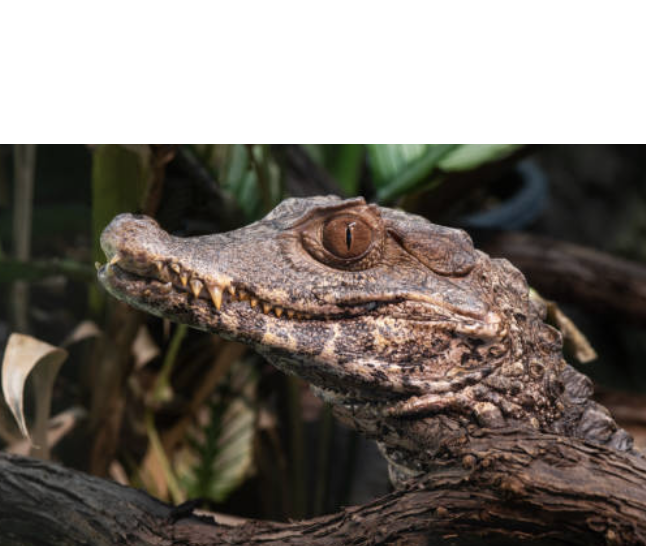
Giant Asian Pond Turtle Heosemys grandis
Conservation: Vulnerable; CITES Appendix II
Habitat: streams, marshes, and rice paddies in altitudes up to 400m above sea level
Diet: Omnivore eating insects, small rodents, fruits, vegetables
Our Giant Asian Pond Turtle: Male, hatch date 8/12/2010 at the National Mississippi River Museum and Aquarium
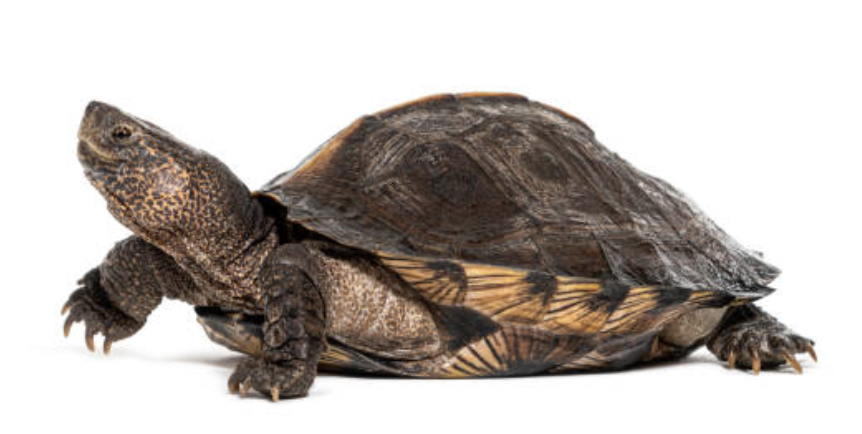
Poison Dart Frogs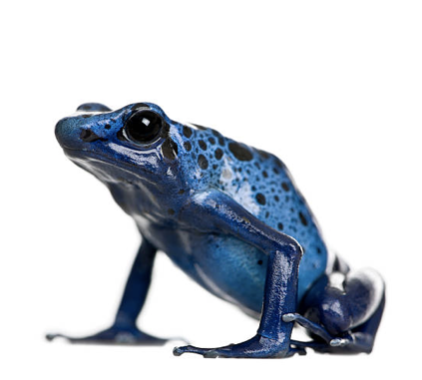
Species present in exhibit:
- Dendrobates auratus- Green and Black Poison Dart Frog
- Dendrobates azureus- Blue Poison Dart Frog
- Dendrobates tinctorius- Dyeing Poison Dart frog
- Dendrobates leucomelas- Yellow-banded Poison Dart Frog
- Phyllobates vittatus- Golfodulcean Poison Dart Frog
Diet: small insects, ours are fed mostly flightless fruit flies and 5 week old crickets
Interesting Information:
The individuals we have are no longer toxic, they obtain their toxicity from the insects they eat in their natural range.
Their bright colors are a form of aposematic coloration, which is a warning to other animals that they are poisonous or have other adverse qualities.
Blue and Gold Macaw (Ara ararauna)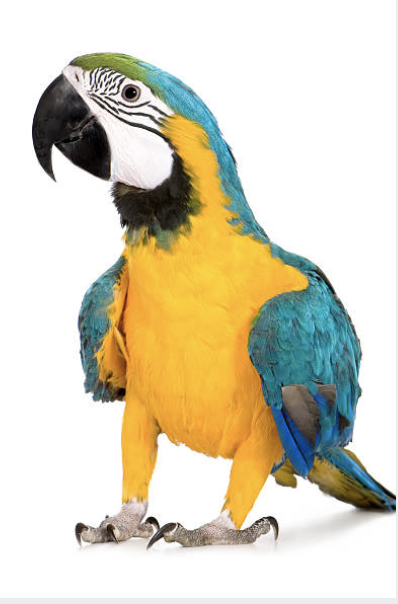
Description: Vivid in appearance. Light blue feathers on top of wings and torso, darker on the tail. Front half of the top of the head covered with lime feathers, back half light blue. Bottom of body light orange feathers. Black beak, white face.
Size: Length 30-34 inches, Weight 2-3 pounds
Natural Range: South America in Venezuela, Brazil, Bolivia, Peru, Paraguay and Ecuador. Range can also extend into Panama.
Habitat: Forests, woodlands and savannahs of tropical South America
Lifespan: 30-35 years in the wild
Reproduction: Sexual maturity is reached between 3-6 years of age. Female typically lays 2-3 eggs with a 28 days incubation. One chick dominates and gets most of the food. Other chicks will die in the nest. The blue and gold macaw typically mates for life.
Diet: Seeds, plant material, fruit and nuts
Our Macaw
Name: Babycakes
Gender: Female
DOB: 1/1/1985
Came to the Aquarium in 2018 from Disney's Animal Kingdom
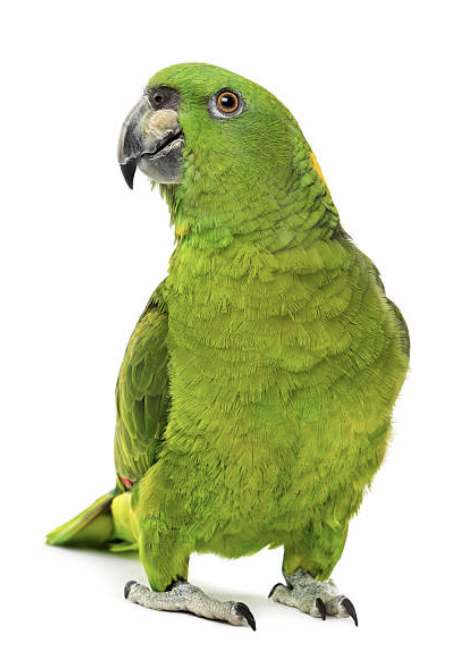 Yellow-Crowned Amazon Parrot (Amazona ochrocephala)
Yellow-Crowned Amazon Parrot (Amazona ochrocephala)
Tropical parrot characterized by a short square-shaped tail and green plumage. It has blue and red secondary and primary feathers along the wing and shoulder, which are difficult to see while the bird is perched. The amount of yellow plumage on the head varies with each individual and within sub-species of this bird. These parrots can have a mass of 400-560g and stand 35cm tall.
Conservation: IUCN least concern. Their populations are believed to be in decline due to poaching for the exotic pet trade, predation during breeding, and habitat destruction.
Natural Range: Found in the Amazon basin and Guianas Additional populations are in northwestern South America and Panama. This species can be found from the low-lands to the rainforests in woodlands, mangroves, and savannas. Can be seen up to 800m in the Andes.
Life Span: Yellow-crowned parrots are monogamous birds. They have a simple courtship display for attracting mates that includes bowing, wing-drooping, wing-flicking, tail-wagging, foot-raising, and dilation of the eye pupils. Breeding season is December - May. During the breeding season mating pairs will produce one clutch of 2-4 eggs. The eggs are plain white with no shell markings and have an elliptical shape. It takes approximately 25 days for the eggs to hatch and have 56 days for them to become fledglings. Offspring become independent about 2 months after they hatch. Both males and females reach sexual maturity at about 3 years of age. Little is known about the life span of this parrot in its natural habitat, but in human care large parrots like these can live up to 100 years.
Diet: They are considered to be opportunistic feeders. They eat fruits, nuts, seeds, berries, blossoms, and leaf buds, which make them seed dispersers of the forest.
Interesting Information:
These parrots are social birds. They are sedentary and only move locally accordance to changes in food supply. At night, outside of the breeding season, these parrots can be found in smaller parties of about 10 birds
Yellow-crowned parrots give off a variety of shrieks, whistles, squawks, and repeated screeches. Like other parrots, they have a complex and flexible repertoire, giving them the ability to mimic human speech.
Yellow-crowned parrots do not have many predators as adults. Boas are primary predators of this species and account for a 9.5% decrease in breeding success each year. Boa constrictors feed on fledgling's and females found in or around the nest.
Our Parrot:
Name: Parker
Gender:TBD
Hatched: Busch Gardens in Tampa on 2/17/2000
Came to The Maritime Aquarium in January 2020 from Discovery Cove in Orlando, FL
Seba's Short Tailed Bat (Carollia perspicillata)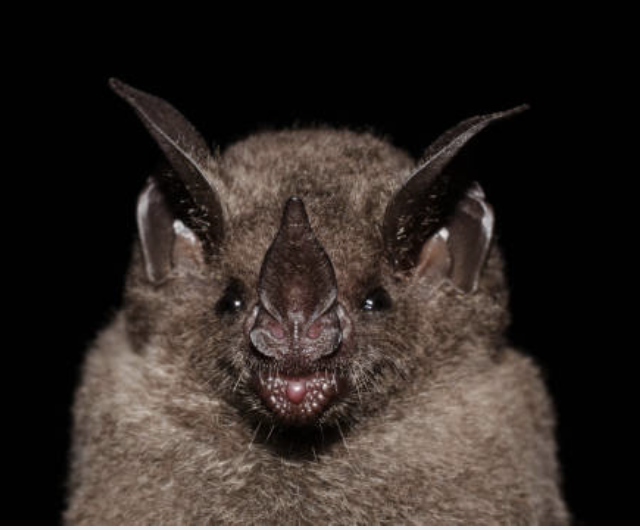
Small to medium sized bat with relatively short ears, and a noseleaf nose. their fur is soft and dense, and can be a variety of colors, ranging from black to brown to gray.
Conservation: IUCN least concern
Natural Range: Central and South America, Mexico to Bolivia, Paraguay, and South East Brazil. They are gregarious with generalized roosts of 10-100 individuals living in caves, hollow trees, and tunnels.
Life Span: Two reproductive periods, The larger one coincides with peak fruit production (June - August) and the other with blooming flowers at the end of the dry season (Feb - May). Gestation is 115-120 days. Young are born precocial and weigh approximately 5g. Young grow quickly reaching adult size in 10-13 weeks and will usually leave the parental harem after about 16 weeks.
Diet: Generalist that tends to forage close to the ground, feeding on approximately 50 different species of fruit, but specialize in the fruits of the genus piper. They also consume pollen and insects.
Interesting information: Seba's short tailed bats are an echolocating bat that is a member of the Phyllostomidaie, a group characterized by a spear-shaped nose. The function of the noseleaf is unknown, but scientists suspect it plays a role in projection of echolocation calls, which are emitted through the nose.
These bats will enter a state of torpor when food is lacking (a state of physical or mental inactivity).
These bats use touch and chemical smells to communicate with one another. Occasionally, males will make vocalizations when boxing (fighting) with another male.
Our Bats: No personal histories. The collection came to The Maritime Aquarium from the Staten Island Zoo.
